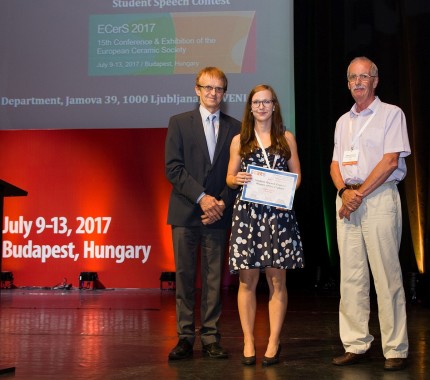Urška Gabor won the 1st place at ECerS 2017

Urška Gabor won the 1st place at the 15th Conference & Exhibition of the European Ceramic Society (ECerS 2017) which was held July 9-13 2017 in Budapest, Hungary. She presented the lecture entitled "Mechanism of the formation of Pb (Mg1 / 3Nb2 / 3) O3-PbTiO3 thin layers using the PLD technique". There were 20 countries participating in the competition, each representing one candidate, which in the case of Slovenia is determined by the Section for Ceramics of the Slovenian Chemical Society. Slovenia won the 1st place in this competition for the first time.
Pb-based materials with PbZr1-xTixO3 (PZT) at the forefront remain to dominate the field of piezoelectrics, as lead-free alternatives are still facing some fundamental and processing issues.1 Epitaxial thin films of Pb[Mg1/3Nb2/3]O3-PbTiO3 (PMN-PT) exhibit piezoelectric properties superior to PZT.2 Notably, the preparation of lead-based materials is also not obstacle-free, the main one being the volatility of Pb. In order to realize the full potential of the materials, formation of Pb-deficient pyrochlore inclusions needs to be circumvented. We have shown that, in addition to meticulous control of the growth parameters and compensating for the lead-loss by using targets with an optimal amount of Pb-excess, it is also very important to select the right underlying material, not only in terms of lattice matching, but also to consider the sticking coefficients for the deposited materials. Despite a smaller lattice mismatch with SrTiO3, LaNiO3 was more successful in stabilizing the perovskite phase. In PMN-PT with three diverse B-site cations it is also imperative to control the ratio of the cations, which is largely affected by the dynamics of the laser plasma plume. In order to understand the material transfer, we examined the composition of the films by means of EDXS analysis using a single-crystal standard. As the process pressure plays a key role in the transfer, films prepared at different pressures were further analyzed with transmission electron microscopy (TEM). We found that increasing the pressure resulted in a substantial improvement of the electrical properties, beyond of what can be achieved by simply avoiding pyrochlore formation. Experiments with oxygen/argon mixtures showed that this effect is not related to oxygen vacancies in the films prepared at lower pressures.
While the formation of ferroelectric PZT has been thoroughly studied and exploited for domain engineering, few studies on relaxor-PT systems can be found in the literature. Understanding the mechanism of the PMN-PT growth process is a powerful tool for improving the quality of the layers, and could furthermore be used to construct guidelines for other multicomponent systems with volatile constituents, including lead-free materials.
